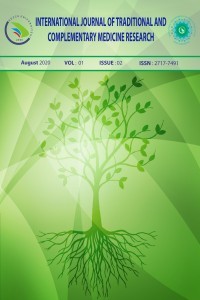Efficacy of Prolotherapy With Periarticular 5% Dextrose In The Treatment of Knee Joint Osteoarthritis
Efficacy of Prolotherapy With Periarticular 5% Dextrose In The Treatment of Knee Joint Osteoarthritis
___
- REFERENCES 1.Felson DT. Osteoarthritis of theknee. N Engl J Med. 2006;354(8):841–8.
- 2.Woo J, Leung J, Lau E. Prevalence and correlates of musculoskeletal pain in Chineseelderlyandtheimpact on 4-year physical function and quality of life. PublicHealth. 2009;123(8):549–56.
- 3.Sayer EC, Li LC, Kopec JA, Esdaile JM, Cibere J. Theeffect of disease site (knee, hip, hand, foot, lowerbackorneck) on employment due to osteoarthritis. Plos one. 2010; 5(5): e10470
- 4.Hawker GA, Gignac MA, Badley E, et al. A longitudinal study to explainthe pain-depression link in older adults with osteoarthritis. ArthritisCare&Res. 2011;63(10):1382–90
- 5.Hutton I, Gamble G, Mclean G, Butcher H, Gow P, Dalbeth N. Obstaclestoaction in arthritis: a communitycase-controlstudy. Int J RheumDis. 2009;12(2):107–17.
- 6.Samson DJ, Grant MD, Ratko TA, Bonnell CJ, Ziegler KM, Aronson N. Treatment of primary and secondar yosteoarthritis of the knee. EvidRepTechnolAssess (Full Rep). 2007; (157):1-157.
- 7.Recommendations for the medical management of osteoarthritis of the hip and knee: 2000 update. American College of RheumatologySubcommittee on Osteoarthritis Guidelines. ArthritisRheum. 2000 ;43(9):1905-15.
- 8.Hochberg MC, Altman RD, April KT, Benkhalti M, Guyatt G, McGowan J, et al. AmericanCollege of Rheumatology 2012 recommendations for the use of non pharmacologic and pharmacologic therapies in osteoarthritis of thehand, hip, and knee. ArthritisCareRes (Hoboken). 2012 ;64(4):465-74.
- 9.Felson DT. Osteoarthritis: prioritiesforosteoarthritisresearch: muchto be done. NatRevRheumatol. 2014;10(8):447-8.
- 10.Kim WJ, Shin HY, Koo GH, Park HG, Ha YC, Park YH. Ultrasound-guided Prolotherapy with Polydeoxyribonucleotide Sodium in Ischiofemoral Impingement Syndrome. PainPract. 2014 ;14(7):649-55.
- 11.Solmaz İ, Akpancar S, Örsçelik A, Yener-Karasimav Ö, Gül D. Dextrose injections for failed backsurgery syndrome: a consecutive case series. EurSpine J. 2019 ;28(7):1610-1617.
- 12.Hauser RA, Lackner JB, Steilen-Matias D, Harris DK. A SystematicReview of Dextrose Prolotherapy for Chronic Musculoskeletal Pain. ClinMedInsights Arthritis Musculoskelet Disord. 2016 ;9:139-59.
- 13.Rabago D, Nourani B. ProlotherapyforOsteoarthritisandTendinopathy: a DescriptiveReview. CurrRheumatolRep. 2017 ;19(6):34.
- 14.Rahimzadeh P, Imani F, Faiz SH, Alebouyeh MR, Azad-Ehyaei D, Bahari L, et al. Adding Intra-Articular Growth Hormone to PlateletRichPlasma under UltrasoundGuidance in Knee Osteoarthritis: A ComparativeDouble-BlindClinical Trial. AnesthPainMed. 2016;6(6):e41719.
- 15.Hussain SM, Neilly DW, Baliga S, Patil S, Meek R. Kneeosteoarthritis: a review of management options. ScottMed J. 2016 ;61(1):7-16.
- 16.Yoshii, Y. et al. Efects of multiple injections of hypertonic dextrose in the rabbit carpal tunnel: a potential model of carpal tunnel syndrome development. Hand (N.Y.) 2014;9(1):52-7.
- 17.Reeves KD, Sit RW, Rabago DP. DextroseProlotherapy: A NarrativeReview of Basic Science, Clinical Research, and Best Treatment Recommendations. PhysMedRehabilClin N Am. 2016 ;27(4):783-823.
- 18.Lyftogt J. Subcutaneousprolotherapytreatment of refractory knee, shoulder and lateral elbow pain. AustMusculoskeletal Med. 2007;12(2):110–112.
- 19.Rezasoltani Z, Taheri M, Mofrad MK, Mohajerani SA. Periarticular dextrose prolotherapy instead of intra Articular injection for pain and functional improvement in knee osteoarthritis. J PainRes. 2017;10:1179-1187.
- 20.Seven MM, Ersen O, Akpancar S, Ozkan H, Turkkan S, Yıldız Y, et al. Effectiveness of prolotherapy in thetreatment of chronic rotatorcuff lesions. Orthop Traumatol Surg Res. 2017;103(3):427-433.
- 21.Sit RWS, Wu RWK, Reeves KD, Rabago D, Chan DCC, Yip BHK, et al. Efficacy of intra-articular hypertonic dextrose prolotherapy versus normal saline for kneeosteoarthritis: a protocolfor a triple-blinded randomized controlledtrial. BMC ComplementAlternMed. 2018;18(1):157.
- 22.Rabago D, Zgierska A, Fortney L, Kijowski R, Mundt M, Ryan M, et al. Hypertonic dextrose injections (prolotherapy) for knee osteoarthritis: results of a single-armun controlled study with 1-year follow-up. J Altern Complement Med. 2012 ;18(4):408
- ISSN: 2717-7491
- Yayın Aralığı: Yılda 3 Sayı
- Başlangıç: 2020
- Yayıncı: Düzce Üniversitesi
Prolotherapy Method in Treatment of Chronic Low Back Pain
Murat Tolga AVŞAR, Resmiye Nur OKUDAN, İlker SOLMAZ, Rumeysa SAMANCİ, Gökhan NALBANT
Büşra KULAKSIZ PİŞKİN, Gülsün Vildan SEYHAN
Murat Tolga AVŞAR, Resmiye Nur OKUDAN, Zeynep Zehra GÜMÜŞ, Rumeysa SAMANCİ
Oğuz Kadir EĞİLMEZ, Mehmet GÜVEN, Ayten YILMAZ, Ebru Mihriban GÜVEN, Mahmut Emre GÜNDOĞAN
Güliz AYDEMİR ACAR, Bilge Betül KILIÇ, Nurhan MEYDAN ACIMIŞ
Buse SENER, Sefa Haktan HATIK, Ali Veysel ÖZDEN, Ayça ÇÖREKCİ
Dilek Özge ZİNCİR ERÇİN, Aysun ÖZLÜ
İsmail EVREN, İlhan ÖZTEKİN, Ali Timucin ATAYOGLU, Noor BUCCHOLZ
The Effect of Aromatherapy Application on the Vital Signs of Intensive Care Patients
Zeliha BÜYÜKBAYRAM, Leyla ZENGİN AYDIN, Eşref ARAÇ
Views of Healthcare Professionals to Traditional and Complementary Medicine
